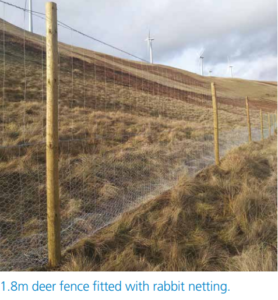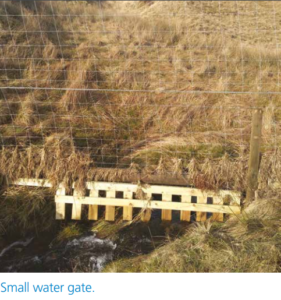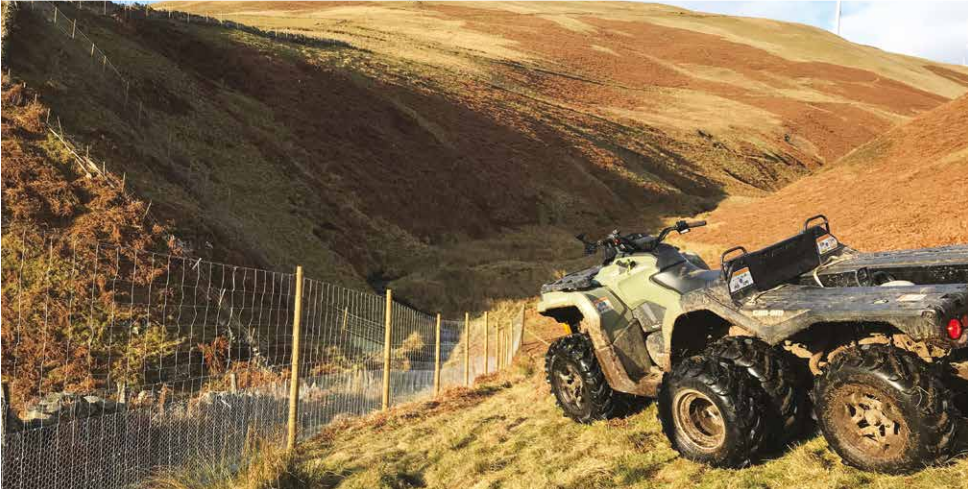The Fencing Contractor – fencing woodlands (FWN32)
18 June 2019Fencing can be one of the most costly parts of creating a new woodland but getting it right is worth the investment to ensure the young trees get the best possible start. Installing deer fencing on lowland agricultural land is usually straightforward but protecting trees on more remote ground and difficult terrain can be more complicated. Contractor Harry McColl specialises in deer fencing, as well as agricultural and garden work. He and his team have experienced the many challenges of forestry fencing and he explained to us how to deal with them and construct a fence that will stand the test of time.
Planning
Access to and across the site is an important consideration for the contractor that will influence their cost to install the fence. The closer they can get vehicles to where they’re working the less time they will spend transporting materials. Usually, small all-terrain vehicles, such as quads, argocats or tracked machines carrying a post driver are used to move around the site and layout materials. On really difficult ground that vehicles can’t reach, materials and equipment will need to be transported by hand, or in extreme cases by helicopter, increasing the time and cost of
the job. Consider if there might be alternative access routes, particularly for reaching the most distant boundaries. Knowing of any particular obstacles, such as boggy areas or difficult water crossings, will help the fencers to plan how they will do the job and travel across the site – getting a machine stuck can lose a lot of time. Usually, contractors will prefer not to store large volumes of materials on site, transporting only what they need for that day. However, if you can offer any secure storage relatively close to the site, this may be helpful.
Where to put the fenceline
The practicality of where to put the fence should be considered from the start of the woodland design process. While some fencelines may be determined by existing boundaries, the path of the new fence can influence how practical it is to install and how long it will last. Fencing over rough terrain or obstacles will increase the time and cost of the work, so it’s worth considering an easier route. Dips in the ground, watercourses and shallow soil over rock should be avoided where possible, and wet or peaty areas and steep slopes will make things more difficult. Try to minimise changes in direction and gradient. If there’s no feasible alternative route there is usually a way to get the fence in, it just might require more time and money. The general line of the fence may be identifiable on maps and satellite photography but it’s advisable to then walk the proposed route with your forestry agent and fencing contractor to decide what’s practical on the ground, and record the route using a GPS. Where deer are present it’s important to keep the fence line away from banks and vantage points that would allow a deer to jump over the fence. Water gates can be made reasonably secure but they will always be weak points so avoid the fenceline crossing burns unnecessarily. In areas that are liable to flood debris in flood water can build up and damage fences. Avoiding rough terrain where possible will result in a stronger fence and can be the difference between the fence lasting 15 years and 20 years. The visual impact of fencelines should be considered, particularly if there is high recreational use nearby. Where the planting area runs alongside a public right of way it’s best to keep the fence pulled back
from the path to avoid it imposing. If a right of way runs through the planting area you will need to provide self-closing pedestrian gates to allow walkers to still access the route and reduce the risk of gates being left open. Members of the public have been known to cut fences open when they have taken exception to being fenced out of a well-used walking route.
Once the woodland design has been finalised, the forestry agent will mark out the decided fenceline on the ground using GPS for accuracy. If the fencing contractor discovers problems as they are putting in the fence, such as unexpected rock that makes post driving difficult, making minor changes to the route to avoid it may be more cost effective than bringing in expensive breaking equipment. These kinds of changes should be expected but should be discussed with the forestry agent to check how a change of fenceline will alter the planting area, or how the additional costs affect the budget.
Fence Specification
Specification varies depending on what you are trying to fence out. The effective minimum height to exclude roe deer is 1.8m, while fences need to be at least 2m high where sika or red deer are present. If there will be livestock in a neighbouring field, the lower h alf of the fence needs to be strengthened, with heavier gauge netting and additional stock posts in between the full height posts – essentially a hybrid stock and deer fence.
alf of the fence needs to be strengthened, with heavier gauge netting and additional stock posts in between the full height posts – essentially a hybrid stock and deer fence.
Where rabbits or hares are likely to be a problem, rabbit netting needs to be fitted to the outside of the lower section of the fence. To prevent wildlife digging underneath, the net should be lapped outward, 150mm beyond the bottom of the main fence net. This apron can either be buried by digging and back-filling a trench, or by bending the net outwards and securing it with pins, see photo. As the vegetation grows up through, this effectively buries the net, often making pinning a more cost-effective approach.
If there are black grouse or capercaillie nearby, the upper part of the fence must be marked to make it more visible and reduce the risk of bird collision. The most appropriate method of marking will depend on the distance from lek sites and the exposure of the location.
If there is already stock fencing along the proposed fenceline, provided it is in good condition (usually up to 5 years old) it can be upgraded to deer fence by adding full-height posts and a top net. This is quicker than replacing with a new fence and unforeseen problems with the ground will be avoided because the hard work of driving in posts has already been done.
When deciding where to put gates, consider regular access required during the first few years to plant and establish the woodland, as well as access for harvesting machinery to enter for thinnings and clearfell in the future. It’s worth investing in good quality galvanised steel gates where they will be used frequently. For gates that will rarely be used cheaper options may be sufficient. If there is evidence of badger movement across the proposed fence line it may be worth installing badger gates, which are too heavy to be opened by rabbits or hares.
Potential Problems
If the fencing team come across an unexpected obstacle they can either move the fenceline to avoid it or do what’s needed to fence through it. If this means a minor deviation from the planned route it’s usually not a problem but they should discuss with the forestry agent and landowner if the change would add or remove a significant area of land. You can then weigh up the effect of altering the route with the costs of sticking to it, for example, extra materials or the hire of rock breaking equipment. Soft ground is less problematic but it does present
challenges. Additional posts, strainers and tie-downs may be needed to secure the fence adding time and cost to the job.
Fencing work can carry on in most weather conditions, only limited by how the ground conditions are affected. Only prolonged wet weather or heavy snow will stop work if the access or running surface for machinery and the squad become dangerous. If there are a lot of deer on site they may need to be removed when the fence is nearly complete. It’s helpful to have a team ready to come in and drive the deer out when the fence is one day away from being closed up. The fencer can leave a gap and create a funnel to help direct the deer out.
Costs
Fencing is generally priced by the metre, plus the cost of specific items such as gates and water gates. The per-metre price will depend on the specification of the fence, and the difficulty of the terrain. A contractor might average 300m of fence per day but work rate could vary from 400m one day on easy ground with good access, to 150m per day on more challenging areas. Where access is difficult the time required for transporting materials around the site will be reflected in the cost.
Maintenance
Good quality fencing materials, installed by a competent contractor should last 20 years. Materials that come with a 15-year guarantee are usually worth the initial investment to minimise the risk of failure and future costs of maintenance. However, a fence is only as strong as its  weakest point so it’s important to check the whole fenceline at least every few months. More vulnerable points, such as water crossings or stretches next to mature trees, should be checked more often, and particularly after bad weather that could cause damage from flooding or fallen
weakest point so it’s important to check the whole fenceline at least every few months. More vulnerable points, such as water crossings or stretches next to mature trees, should be checked more often, and particularly after bad weather that could cause damage from flooding or fallen
branches. Where there is heavy pedestrian or vehicle traffic through gates these should be kept in good working order as you can’t rely on everyone passing through to wrestle with a difficult latch.
What should you look out for when checking the condition of a fence? Loss of tension in the line wires indicates that something has failed further down the fenceline, such as broken or fallen strainer, or snapped/cut wire. Modern netting is made from spring steel which maintains tension and doesn’t deform, so can withstand deer or livestock pressure. Deer can squeeze through surprisingly small gaps, often getting under the bottom net or between the top and bottom nets, so check the top, middle and bottom. Make sure any
rabbit netting is well fastened to the main netting and remains pinned or dug into the ground.
If a fence does become damaged, the contractor who installed it should make it a priority to repair and minimise the time the trees are vulnerable to wildlife. Often repairs will be a relatively quick and easy fix. For example, a fallen tree on the fence may look worse than it is; once the tree is cut and removed the high-tensile wire will spring back and the work may only be to replace any broken posts and re-tighten the wire.
Forestry Grant Scheme Funding
Funding is available for the capital expenditure involved in putting in forestry fences for new Woodland Creation schemes. This is paid per metre of fencing, with different rates appropriate to the specification required. There are also payments for vehicle and pedestrian gates. The Forestry Grant Scheme recognises the additional cost of deer fencing in a more remote location and offers a higher rate of funding in these areas. A well-designed fence, installed by a competent contractor using good quality materials should protect your trees until they’re established enough to withstand deer pressure. Getting it right from the beginning is a sound investment to ensure you grow a valuable timber crop, or create a healthy native woodland.
Harry McColl, Harry McColl Fencing Ltd & Leona Baillie for the Farm Advisory Service
This article has been published in the Spring 2019 edition of the Farm Woodland News. Download a copy to access all articles. Subscribe to receive newly published editions via email by using the form here.
Sign up to the FAS newsletter
Receive updates on news, events and publications from Scotland’s Farm Advisory Service

